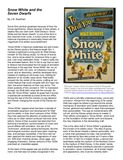Some films achieve greatness because of their historical significance, others because of their artistry. A relative few can claim both. Walt Disney’s “Snow White and the Seven Dwarfs” is one of the films in this charmed inner circle, a motion picture whose historical importance is inextricably linked with the magnitude of its artistic accomplishment.
“Snow White”’s historical credentials are well known: as the Disney studio’s first feature-length film, it marked a significant turning point for Walt Disney himself, for the Disney studio, for the art of animation, and to some extent for American films in general. Like most celebrated “firsts,” it wasn’t really the first animated feature. But it’s fair to say that no earlier feature had showcased the full range of animation technique in the way that “Snow White” did, nor so combined it with rich color, an infectious musical score, and an absorbing, carefully developed story. Instead of creating an arthouse curio, bidding for attention on its novelty value alone, Walt boldly jumped into the center of the arena, crafting an animated feature that could compete with the major studios’ live-action features on their own terms. The sheer audacity of this concept in 1937 is impressive enough, but Walt didn’t stop with the concept. So fully did “Snow White” realize its goals that it scored a spectacular worldwide success at the box office, forcing the rest of the film industry to pay attention, and forever changing the course of the Disney studio.
“Snow White” capped what had been a decade of remarkable expansion and development for Walt and his artists. In their short cartoons of the 1930s, they had captured the attention of audiences and critics as no other cartoon producer had ever done before. Some of their success had stemmed from technical innovations: synchronization of music and sound effects with animation, the use of full
Technicolor, advanced camera techniques. But this technological evolution would have been meaningless, and perhaps impossible, if the films had not also captured the hearts and imaginations of viewers. With their inventive stories, clever gags, and engaging characters, Disney cartoons of the 1930s exercised an irresistible appeal.
At the heart of that appeal was yet another development, one that was not widely recognized in the 1930s and is still little understood today: personality animation. Almost from the beginning of his career, Walt had urged his artists to go beyond the simple mechanics of animation and create characters who moved, gestured and walked in ways that expressed their personalities. This was an extraordinarily difficult art, and the Disney artists strove to master it. Their efforts culminated in “Snow White”, which built on the foundation of their earlier work and became the new milestone in this demanding craft.
[...]

